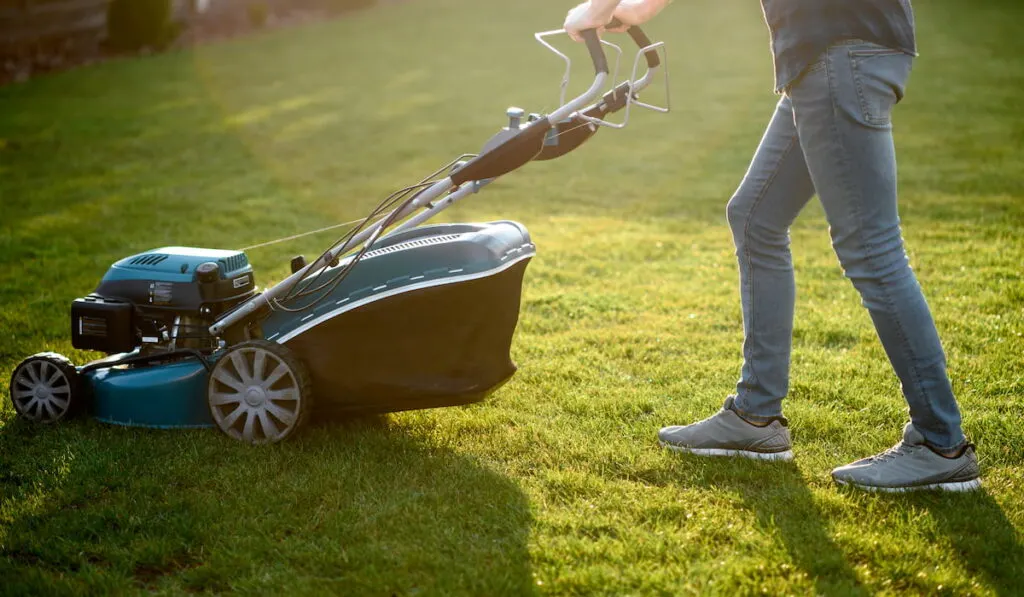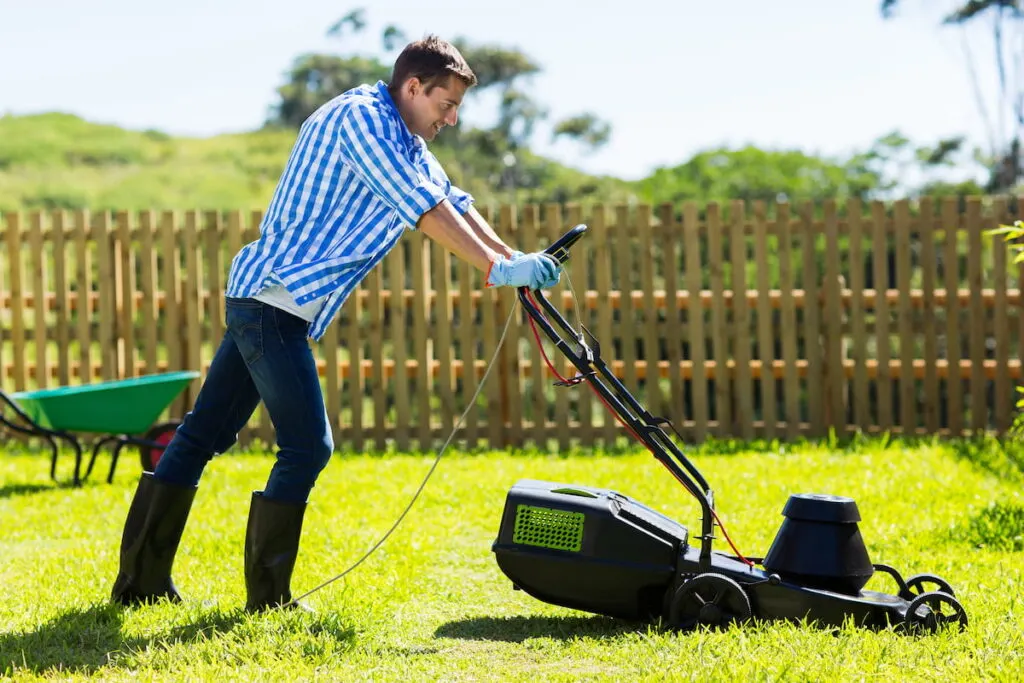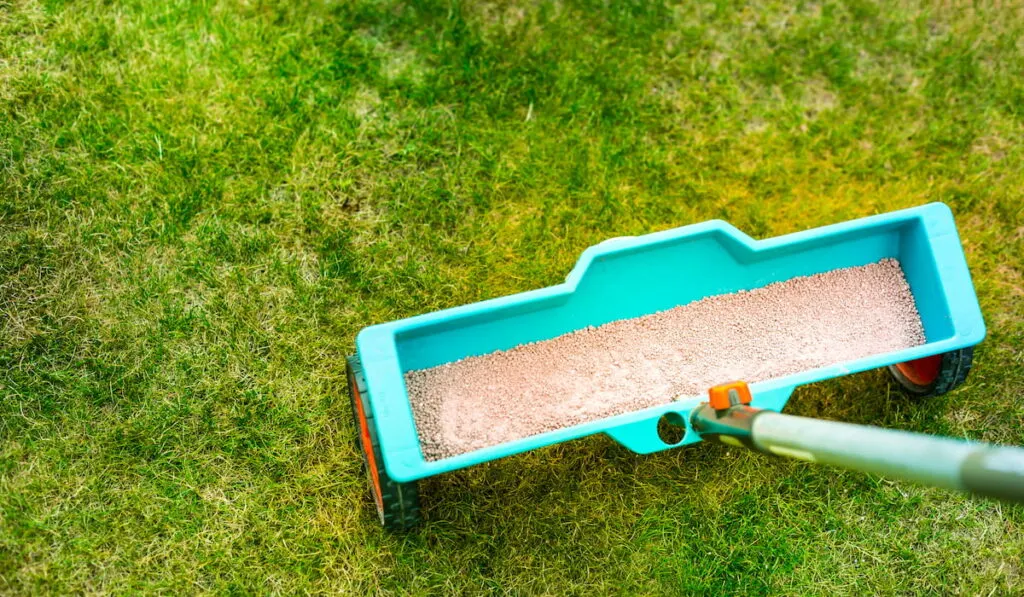Spring is here and the sun is finally out which means it’s time to take the lawnmower out and remove the dust off your gardening tools to prepare your backyard for the upcoming season.
Whether you are getting ready for guests and house parties, or you simply want to rearrange your little peaceful corner for some good family time, you will enjoy it more after you mow your lawn.

Mowing is an important part of your lawn care, so let’s check how even beginners can get the most out of it!
Table of Contents
Things To Check Before You Mow Your Lawn
Before you start mowing, do a pre-cut tidy. It’s really important to remove all the smaller objects that got lost in your yard.
Remove any leaves, stones, rubbish, branches, or dead sticks that may be lying around or gathered through the wintertime.
Not only will these obstacles bother you while mowing, but they can also cause damage to the mower blade.
Lawnmower Basics
A good lawnmower will make the work easy – it has a horizontal blade that spins around so quickly it cuts the grass the moment the mower hits it.
That blade is placed within a deck whose purpose is to keep both grass and other objects from flying in different directions when struck.
That casing we call the deck rides on four wheels with a motor on top of it.
Together with that, sometimes there’s an attached bag that collects the cut grass.
When you cut your lawn, simply take a mower’s handlebar and push it to move forward.

You Took Your Mower Out – Now What?
Before you start, take your mower and sharpen its blades.
When they are blunt, blades don’t slice the grass as they should, so it won’t have the effect you want.
Blunt blades can leave an open wound on the grass and that will look ugly or your grass may end up ragged at its edges which will cause browning.
Aside from that, this could put your lawn at risk for some grass diseases.
Try to keep your mower blade sharp to make the best of it.
When To Start?
You have a freshly turfed lawn, and now you want to start with mowing – but you’re not sure when to do it.
If you go for it too early, it can cause strain for the young plants.

On the other hand, if you wait for too long, you may miss the chance to thicken the sward when it’s still at its early stage.
There’s a little test you can do to see if your lawn is ready for a cut.
Just tug on a handful of grass. If you see the turf is lifting, that means the roots need a bit longer to settle in.
In that case, do the test once again in a couple of days to see if it’s ready.
If the next time grass blades break off when you grab them, that’s a good sign – you can mow your newly turfed lawn for the first time.
How Long Your Grass Should Be Before You Start Mowing?
Pay attention to the grass length because that can help you decide when the right time is to start cutting your lawn.
After winter ends, it’s good to wait for your grass to be around 2 inches (5-7 cm) tall before you go for a cut.
That way, you reduce the possibility of injuring your grass; when you cut it too short, you increase the possibility of diseases.
You will get this length approximately 6-8 weeks after sowing.
When your grass is shorter than that, the root hasn’t developed enough; that means it’s not going to be able to support the plant during the recovery process.
Then again, if you let it grow over the recommended length it will be harder to control its growth later – plus, when it’s too long, it can cause problems with your mower.
Go With The One-third Rule!
When you start mowing for the first time, stick to the one-third rule – don’t cut more than a third of grass blades in just one go.
Cutting your grass more than this for the first time can cause damage, open the way for diseases, and cause weed infestation.

Try to gradually reduce its length and go for a lower level each time you mow.
Don’t Mow Wet Grass
When you decide to do some serious mowing work in your backyard, choose a day when the weather is nice and the conditions are dry.
Wet grass blades can stick and clog your mower – plus, it’s much harder to cut the grass equally causing you to spend more time doing the work with lackluster results.
Coupled with this, don’t mow the grass when there’s frost on it.
Don’t Take Just One Direction, Change It!
Try to avoid cutting your grass in the same direction all the time.
If you roll your mower the same way every time, your lawn will develop certain mowing line patterns or ruts.
Try to change directions; go with vertical rows the first week, change it to horizontal the next one, and go diagonally after that.
Don’t Forget To Fertilize
After you are done with mowing, give your lawn some nutrients by fertilizing it.

That way, it will get a great boost to grow well during the entire season.
Not that you have to do it every time – the optimal period to fertilize is during late summer, fall, or early spring.
How Often Should You Mow?
It’s optimal to cut your grass once a week, but some lawns simply require to be mowed more often.
Sometimes the grass grows more slowly so you will need to cut it every two weeks.
Generally speaking, just remember the one-third rule – don’t cut more than that because it can cause harm to the grass blades.
The length is the criteria you need to estimate when to mow your lawn again, not the day you mowed last.
A Couple Of Final Words
If you trim your lawn on a regular basis and stick to these recommendations, it’s easy to have a beautiful, healthy backyard you can be proud of.
Moreover, it’s way better and simpler to set your lawn with the first cut, because that way, your grass will remain healthy and grow properly.
Do you have some more tips you’d like to share with us – or perhaps have some questions we didn’t answer? Either way – we are here for you!
Sources:
- https://thegrasspeople.com/grass-first-mow/
- https://www.countryliving.com/uk/homes-interiors/gardens/advice/a1522/how-to-mow-lawn-first-time-year/
- https://www.turfonline.co.uk/blog/mowing-your-lawn-for-the-first-time/#:~:text=For%20the%20first%20cut%2C%20set,for%20a%20few%20weeks%20yet
- https://www.myallgreen.com/mowing-your-lawn-for-the-first-time-this-season/
- https://home.howstuffworks.com/lawn-mower.htm
- https://www.ecogreen.ca/how-often-should-i-mow-my-grass/#:~:text=Normally%20weekly%20mowing%20is%20the,that%20may%20harm%20the%20grass.
